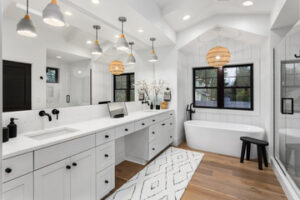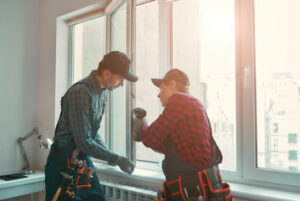The bathroom is one of the most frequently used parts of any home. That’s why it’s no wonder so many homeowners want to remodel their bathrooms.

A full bathroom remodel usually involves expanding the square footage and moving walls, and is more extensive than a renovation. However, it can add tremendous value to your home. Contact Bathroom Remodeling Princeton NJ for professional help.
A bathroom remodel is an opportunity to transform a room that you use every day into something that brings you joy and increases the value of your home. However, it’s important to take the time to plan your project thoroughly and make sure that you have a realistic budget before you start. This will help you avoid unpleasant surprises midway through the renovation.
There are different levels of bathroom remodeling – from simply covering up existing features to totally revamping the space. Depending on your budget, you may want to hire a professional to complete the work or do it yourself. It’s essential to understand that the level of bathroom remodeling you choose will affect how long it takes and what your final results will look like.
It is essential to address any plumbing problems before moving forward with cosmetic improvements. Water leaks can lead to wood rot, mold and other health issues. It’s also a good idea to replace old toilets with newer, more efficient models and swap out inefficient tubs and showerheads for energy-saving options.
Adding storage solutions such as cabinets, shelving units or vanity drawers helps keep the room clutter-free and improves organization. If possible, consider using natural light to create a bright and inviting atmosphere that promotes happiness and wellbeing. Adding plants or nature-inspired artwork can also help enhance the connection with the outdoors and has been shown to boost mood. Finally, installing dimmable lighting fixtures allows you to customize the brightness according to your personal preferences and mood.
Budget
Remodeling a bathroom is a big project that can be expensive. It’s important to have a budget and a plan before you begin to help manage costs and avoid any surprises.
It’s also important to understand the difference between a renovation and a remodel. A renovation is generally a more cosmetic upgrade, while a remodel involves significant changes to the layout and functions of the space. Depending on the extent of the change, a remodel can be more costly than a renovation.
The size of your remodel budget will depend on the scope of the work and the quality of materials. The most significant expense is often labor, as it takes a skilled crew to install new fixtures, cabinets, and other components correctly.
Choosing the right materials is another way to reduce cost. Eberhardt recommends shopping around and comparing prices to find the best deal on everything from peal-and-stick tiles to custom cabinetry. He adds that homeowners can save on flooring by resurfacing or reusing existing tile rather than replacing it entirely. Upgrading lighting fixtures can also be a budget-friendly project, as can adding accessories like soap dispensers, towel bars, and hooks.
A full bathroom remodel is typically the most expensive type of remodeling, as it involves changing the existing layout and may require rerouting plumbing or electrical wires. It is essential to work with a qualified contractor for this type of major remodel, as any mistakes could be costly and time-consuming to fix.
While a bathroom remodel can be an overwhelming project, it can also add significant value to your home and improve the function of your daily routine. With a little planning and careful attention to detail, you can create a beautiful, functional space that fits within your budget and timeline.
Layout
One of the most important aspects of bathroom remodeling is determining the layout. A well-designed layout will maximize space, increase functionality and enhance your bathroom’s aesthetics. There are a few different layout options for bathrooms depending on how much space you have available.
One option is to use a stacked vanity with a toilet in the center. This is great if you’re looking to keep the room open and avoid cluttering. Another option is to use a freestanding tub in the corner of the room. This is a great way to create a focal point and add some drama to your bathroom. If you’re unsure about what to do with your bathroom, a professional can help you find the best layout for your space.
You can also create a separate shower and tub with this layout. This is ideal for smaller bathrooms that don’t have enough space for a full bathtub. The shower can be designed with eye-catching tiles to act as a focal point in the room while the tub is placed in a more discreet location.
A large, soaking tub can add a sense of luxury to any bathroom. It’s important to consider your lifestyle when choosing the size and shape of your tub. For example, if you’re planning to have children, a small, shallow tub may be better than a larger tub that’s harder for them to get into.
If you’re working with a tight space, a careful arrangement can fit a tub, shower and double sink into a 64-square foot room. This layout also retains space for a cabinet and keeps the toilet and tub private thanks to inner partition walls.
Materials
The materials you select for your bathroom remodel will impact not just the aesthetics of the space but its durability and maintenance requirements as well. Choosing high-quality materials that blend functionality with design is crucial to the success of your renovation.
Tile is a popular choice for bathroom surfaces due to its versatility and beauty. Glazed porcelain tiles are durable and have a low.5% porosity that makes them water-resistant and stain-proof, making them a smart choice for wet environments. Other popular options include quartz countertops, which add a sense of luxury to your space and are more resistant to mold and mildew than other types of counters.
Other materials like glass, metal, acrylic and wood offer a modern aesthetic to your bathroom that can complement the overall design of your space. These materials also vary in price, so it is important to keep budgetary concerns in mind during the selection process.
A well-executed bathroom remodel can add significant value to your home, especially if you choose materials that are functional and energy-efficient. For example, installing a new shower stall can convert your outdated tub into a spacious walk-in shower, while new fixtures and appliances can save you money on your energy bill.
Adding a skylight or windows can make your bathroom more open and airy, creating a bright and inviting environment that promotes well-being. Moreover, installing dimmable lighting fixtures allows you to adjust the brightness of your bathroom to match your mood and activity. Safety upgrades, such as textured flooring and non-slip bath mats, can reduce the risk of falls in wet conditions. These features are especially beneficial for older family members or people with mobility issues.
Contractors
Professional contractors have the knowledge and expertise to handle all aspects of the renovation. They will help you achieve the bathroom design that is unique to your home and reflects your personal style. They will also offer suggestions on materials and fixtures that meet your budget. They will provide detailed project estimates and timelines, allowing you to plan ahead for your remodeling project.
A well-planned and professionally executed bathroom remodel will boost your home’s resale value. According to experts, this is one of the best investments you can make. Not only will a modern, stylish bathroom attract potential buyers, but it will also increase your daily comfort and enjoyment of the space.
Whether you choose a sleek, contemporary style or classic elegance, a professional bathroom remodel will give your space an updated look that complements your home’s décor and style. They can replace the tub with a spacious walk-in shower, install the sink in the corner, and incorporate built-in, ceiling-height storage shelves. They can also add a window, which will reduce the need to turn on the fan for long periods of time and keep walls and mirrors from fogging up.
If you are considering a home improvement project, you should consult with multiple contractors to compare pricing and services. Ask for references from past clients to gain insights into the contractor’s reliability and quality of work. It is also a good idea to check for licensing and insurance. This will protect you from liability and ensure the safety of all parties involved in the renovation project. During the renovation process, you can also implement energy-efficient features that will lower your utility bills and appeal to environmentally conscious buyers. These include low-flow toilets and faucets, as well as LED lighting.

